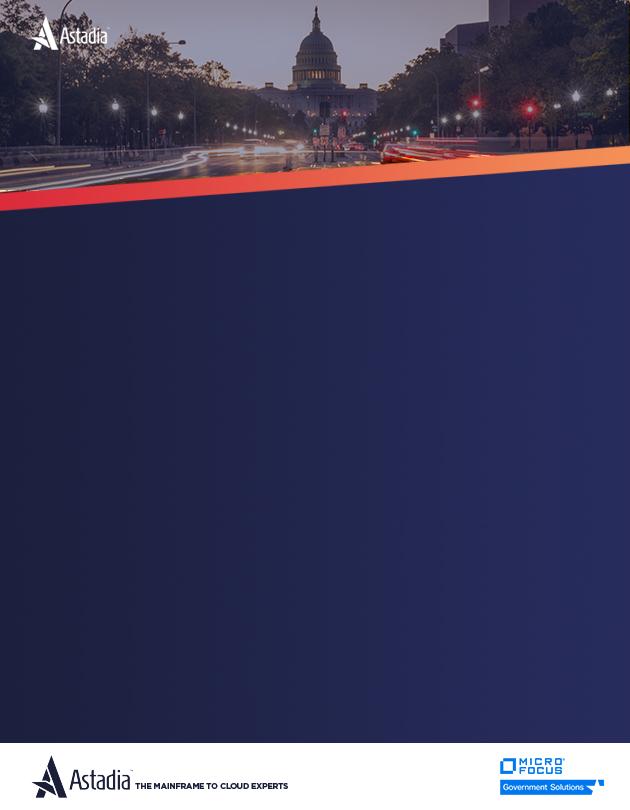
5 minute read
8 Areas of Progress & Improvement in Government Technology
8 A R E A S O F PROGRESS & I M P R O V E M E N T I N G O V E R N M E N T TECH
In his keynote at GovLoop’s “Gov’s 2020 Tech Focus” virtual summit, Craig Fischer, a Program Manager at FIT within the Bureau of the Fiscal Service, discussed four areas where the government is currently doing well, along with four areas in which it could improve going into the 2020 technology landscape.
Advertisement
WHERE THE GOVERNMENT DOES WELL
1. Starting small and starting simple With the excitement that surrounds new technologies, it’s easy to get ahead of ourselves. Fischer cautioned against letting our eyes become bigger than our stomachs and going after technologies without a plan.
Instead, he recommends breaking projects down into smaller chunks and then choosing the right piece of technology. Instead of tasking IT teams with tackling a new technology full stop, provide them with smaller, actionable areas where they can implement the right solution bit by bit.
2. Finding comfort in the unknown Fischer shared that in his experience, every technology project has taken some kind of unexpected turn. Although that’s common across many fields, it is especially so for teams working with new and emerging technologies. Fischer urged teams to accept this reality and expect the unexpected in their project plans. Exploring the possibilities of the unknown is a huge part of the process and approaching each case as an opportunity to learn can yield only more fruitful results.
3. Practicing radical transparency Fischer acknowledged that sometimes teams, including his own, have kept their work on new projects under a cloak of secrecy before involving others and getting leaders on board, but this can be extremely counterproductive. Teams should allow themselves to be more outcomeindependent when exploring the uses of new technologies, Fischer said. The whole process will benefit from having more eyes and more perspectives involved.
4. Appointing designated teams Because of the ever-growing vastness of the emerging tech field, Fischer stressed the importance of having separate teams dedicated to proactively searching for and implementing new technologies. These teams should scan the news and reports from other agencies about new technologies. In addition, they should constantly analyze the agency’s processes and never stop asking, “How could these be improved?”
WHERE THE GOVERNMENT COULD IMPROVE
1. Absorbing the pace of change From AI to blockchain and RPA – not to mention the remaining galaxy of technology making its way into the mainstream – describing the amount of change government IT departments face as “overwhelming” would be a massive understatement. Fischer said that moving forward, it’s imperative that agencies take a tactical, critical approach to modernization and selectively prioritize certain projects to protect their spread-thin IT departments from overload.
2. Keeping up while technology leads the pack At this moment, technological progress is vastly outpacing current policies, practices and, sometimes, even laws, Fischer said. If we want to see these new technologies successfully find a place in government, agencies must find ways to be adaptive and better negotiate how to fit new tech into the rigid structures that have already been established, he added.
3. Confronting organizational cultures Many agents of change support modernization efforts, but Fischer noted that there are also many employees who oppose change. It can be very challenging to get these individuals on board with new projects, especially if they lead the decision-making process.
One strategy that Fischer emphasized is that when you are describing a new technology pilot to leaders, do not focus on how it works. Instead, highlight the technology’s specific, tangible benefits and how it will improve mission-critical processes.
4. Fostering cross-agency collaboration Agencies don’t regularly share projects, use cases or lessons learned, Fischer said. Because of the challenging pace of emerging technology, he said that there is immense value to be gained by exchanging this information and that the implementation could be revolutionized at all levels of government.
BEST PRACTICE: CULTIVATING A ‘SCANNING’ CULTURE
At GovLoop’s “Gov’s 2020 Tech Focus” virtual summit, Fischer discussed the importance of making it a practice to always monitor the media and other sources for new and emerging technologies and tech strategies. Fischer said that he first started paying attention to blockchain after reading an article in the Wall Street Journal about how the technology was working in the finance space. That got him thinking about how it might work in the federal domain, which led to more focused research, a presentation to agency executives and eventually blockchain pilots. “One of the things that I think you have to do is make this scanning part of your organizational culture,” Fischer said. “It just has to be part of the job that you do – always being on the lookout.”
Don't let legacy technology get in the way ofthe future

















